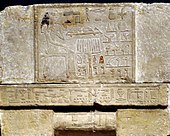Mastaba of Hetepet
The ancient Egyptian mastaba of Hetepet was excavated near Giza in 1909 and dates to the Old Kingdom , probably the 5th Dynasty, around 2500 BC. The exact location of the mastaba was not recorded at that time. Various reliefs were removed from the burial chapel and ended up in the Liebieghaus in Frankfurt and the Egyptian Museum in Berlin . Hardly any records have come down to the excavations of Karl Maria Kaufmann , so that nothing more was known about the grave for a long time. The grave was found again in Giza in late 2017. The decoration of the chapel was well preserved and is largely painted, which is rather unusual for this period.
Little is known about Hetepet as a person. She carried the title of priestess of Hathor , royal acquaintance and landowner . Her father's name is only partially preserved and began with Nef ... The name of a possible husband has not been passed down.
Individual evidence
- ↑ The fragments are all photographically reproduced in: Henry George Fischer : Egyptian Women of the Heracleopolitan Period. 2nd edition, The Metropolitan Museum of Art, New York 2000, ISBN 0-87099-967-2 , panels 1-4 ( online ).
- ↑ A. Woods, J. Swinton: Chronological considerations: Fragments from the tomb of Hetepet at Giza. In: Bulletin of the Australian Center for Egyptology. (BACE) Volume 24, 2013, p. 127.
- ↑ Erika Engelhaupt: See Inside the Tomb of a High-Powered Egyptian Woman . On: news.nationalgeographic.com ( National Geographic ) February 3, 2018.

